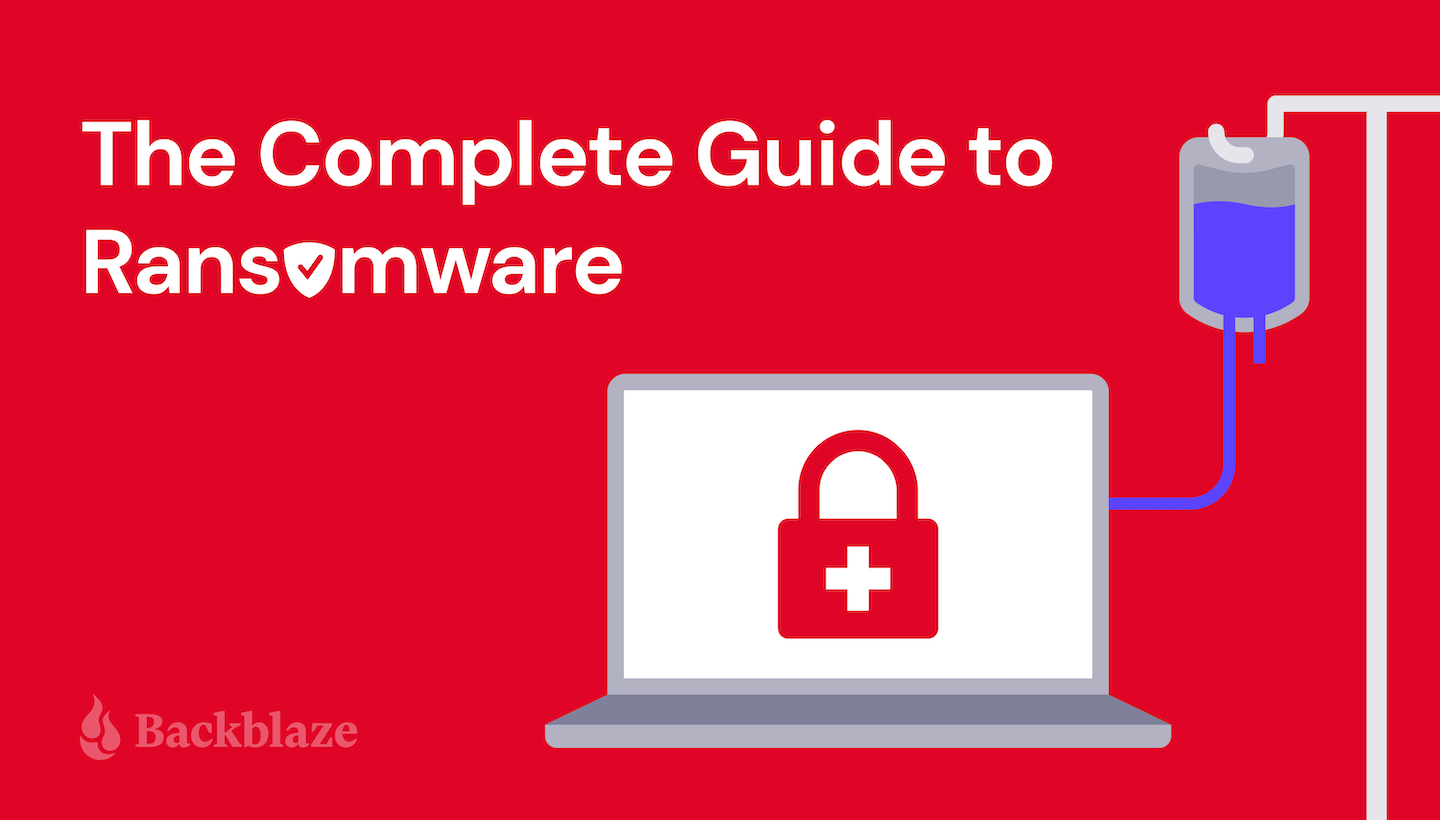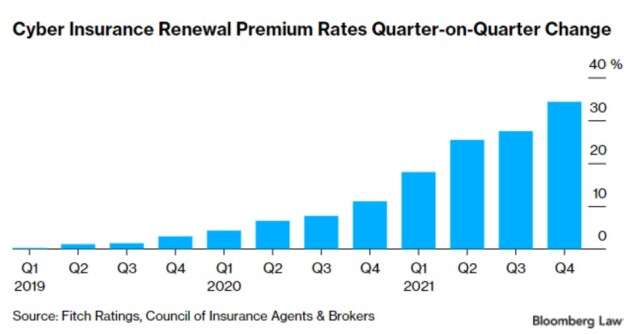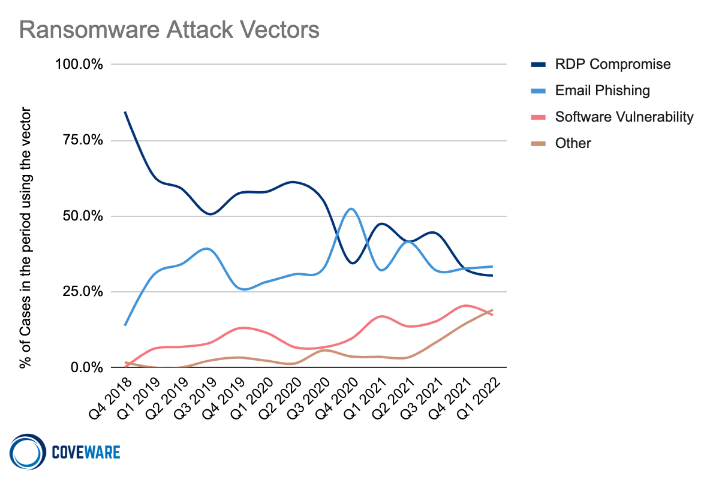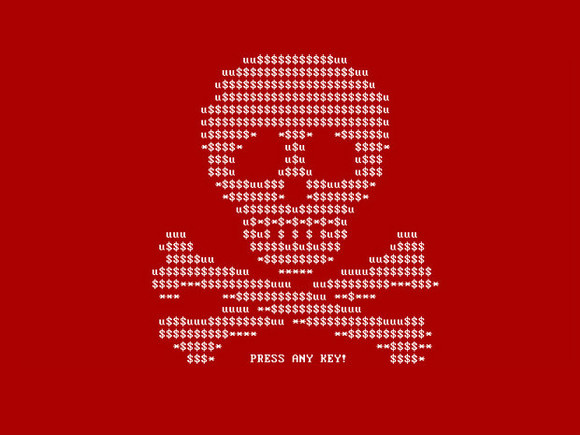
Information technology’s a nightmare scenario faced past thousands every year.
Maybe you lot’ve beaten the odds so far, only in that location may come up a day when you kick upwards your laptop, only to find yourself the victim of a ransomware set on.
You might non even realize information technology at first, the only signs being odd drops in file associations, lag times, and slowdowns. Y’all might chalk it upward to a glitch…until the IT department calls yous.
And when they say those iii words no one wants to hear, “We’ve been breached,” information technology will all start to make sense. Specially when you glance down to your screen and come across the inevitable truth in black and white (Or ruby-red with yellow hazard stripes. Or a skull and crossbones. What can we tell you, scammers have a sure style guide they attach to).

You’ve been infected with ransomware. You accept lots of company.
This mail service was originally published during April of 2019 and updated in July of 2022. Sadly, ransomware has only become more prevalent since and so. We’ve updated the mail service to reverberate the electric current state of ransomware and to help individuals and businesses protect their data.
In 2021, the FBI’s Cyberspace Crime Complaint Center received 3,729 ransomware complaints, and those are just the ones that got reported. Cybersecurity Ventures expects that, past 2031, businesses will fall victim to a ransomware set on every other 2nd, up from every eleven seconds in 2021, every 14 seconds in 2019, and every xl seconds in 2016—an acceleration greatly influenced by the rise of remote work post-obit the global pandemic.
These trends show us that ransomware attacks are rising at an exponential rate. As such, the fiscal touch on will go along footstep. An attack on corporate networks that encrypts sensitive data tin can toll businesses hundreds of thousands—even millions—of dollars. That aforementioned Cybersecurity Ventures report states that ransomware amercement reached $20 billion in 2021, and predicts that number to hit $265 billion by 2031.
Ransom amounts are too reaching new heights. One house, CNA Financial, paid a historic $40 one thousand thousand ransom following a 2021 attack, possibly the largest payout to date. In 2021, payment amounts declined throughout the year, with Coveware reporting average payments of $136,576 for Q2 2021, a decrease of 38% from the previous quarter. This was due to increasing pressure from law enforcement, merely seems to have only been a temporary setback. Unit 42 reported an overall increase in ransom payments of 78% past the end of last year.

Ransomware affects all industries, from tech to healthcare, and oil and gas to higher education. Perchance the near interesting new development has been the rise of attacks against public sector entities. Perhaps spurred by the recent legislative action in a handful of states, which bans the use of tax dollars for ransom payments, hackers have begun targeting smaller, privately-held businesses across all industries.

Ransomware continues to be a major threat to businesses in all sectors, but more and more we run across the greatest impact being leveled at businesses betwixt 11 and i,000 employees. The aforementioned Coveware study shows that companies of this size made up the vast majority (lxx.4%) of all companies impacted by ransomware attacks.
Regardless of your firm’s size, you lot’ll desire to empathize how ransomware works and how recent changes to the law might impact your strategy.
Ransomware and The Law: New Developments
While the federal government has continued responding to these new and evolving ransomware threats, it has pivoted its stance.. For a long fourth dimension, the FBI’s guidance was essentially, “don’t pay the ransom, merely report information technology.” Occasionally, field offices would event reminders to businesses in their jurisdiction to eternalize their security, but for the almost office the authorities operated in more than of an informational chapters.
Last yr, however, the Justice Department hinted at implementing proactive measures to ensure attacks are reported. Speaking at a Senate Judiciary Committee, Deputy Assistant Attorney General Richard Downing was quoted by The Washington Post saying, “The government and Congress does not take a full picture of the threat facing companies. Congress should enact legislation to require victims to report.”
This followed the Colonial Pipeline Hack and lawmakers’ subsequent button to not only crack downwards on those who perpetrated the acts but also bolster requirements to notify authorities later on the attack.
Nothing has been passed still, just the winds are shifting towards greater responsibility on the victim to written report ransomware attacks.
Ransomware Insurance: An Ounce of Prevention
Cyber insurance is nil new.For over a decade, providers accept offered policies that encompass outages from viruses, data lost to hackers, and other assorted online pitfalls. Ransomware claims, nevertheless, take skyrocketed—at present accounting for nearly 75% of all claims filed.
Consequently, the cost of coverage has continued apace, with premiums rising to unprecedented levels. Utility companies, already under the spotlight after Colonial, have seen increases of 25-xxx% in their premiums. In some cases, premiums have risen 74%.

How Does Ransomware Work?
A ransomware attack starts when a machine on your network becomes infected with malware. Hackers have a variety of methods for infecting your machine, whether it’s an attachment in an electronic mail, a link sent via spam, or even through sophisticated social engineering campaigns. As users become more savvy to these attack vectors, hackers’ strategies evolve (see department six, “How to Forbid a Ransomware Attack”). Once that malicious file has been loaded onto an endpoint, it spreads to the network, locking every file it can access backside strong encryption. If you desire through that encryption, yous’ll accept to pay the price.

Encrypting ransomware or cryptoware is by far the most common recent variety of ransomware. Other types that might be encountered are:
- Non-encrypting ransomware or lock screens (restricts access to files and data, but does not encrypt them).
- Ransomware that encrypts a drive’s Master Boot Record (MBR) or Microsoft’s NTFS, which prevents victims’ computers from existence booted upward in a live Os environment.
- Leakware or extortionware (steals compromising or damaging data that the attackers and then threaten to release if ransom is non paid).
- Mobile device ransomware (infects cell-phones through bulldoze-past downloads or simulated apps).
Latest Trends in Malware
Over the past year, one long-continuing trend that has recently gained popularity is ransomware as a service (RaaS). Through dark-web vendors, cybercriminals only need the opportunity to infect your system, relying on software they employ in commutation for giving the developers a cutting. This means that ransomware attacks no longer require much cognition on the attacker’due south part.
This tendency has naturally led to a massive uptick in attacks, pregnant the next one isn’t a question of if, but when. As such, information technology’s amend to be overly prepared when it comes to It security, and the importance of bankroll upward and securing your data should be mutual practice for organizations both large and pocket-sized.
What Happens During a Typical Attack?
- Infection: Whether through a phishing email, physical media (e.k. thumbdrive), or whatsoever other method, the ransomware need only install itself on a unmarried endpoint or network device to gain access.
- Secure Key Exchange: One time installed, the ransomware sends a signal to the perpetrator’due south central command and command server to generate the cryptographic keys that will lock the arrangement.
- Encryption: With its lock in place, the software will begin encrypting any file it can find, both on the local auto and across the network.
- Extortion: Now that it has gained secure and impenetrable access to your files, the ransomware will display an explanation of what comes side by side—details of the exchange, the ransom corporeality, and the consequences of non-payment.
- Unlocking or restoring: At this point, the victim can either attempt to remove infected files and systems and restore from a make clean fill-in, or pay the ransom. If you lot are forced to pay, negotiating is e’er an option, with Unit 42 reporting that average payments generally ran 42.87% of what was initially asked.
Who Gets Attacked?
Ransomware attacks target firms of all sizes—5% or more of businesses in the tiptop ten industry sectors have been attacked—and no business, from small and medium-sized businesses to enterprises, is immune. Attacks are on the rise in every sector and in every size of business concern. This leaves pocket-size- to medium-sized businesses particularly vulnerable, every bit they may not take the resource needed to shore up their defenses. With recession fears on the rise, they may exist hesitant to invest in ransomware protection.
Too, the phishing endeavor that targeted the Globe Health System (WHO), though unsuccessful, proves that no entity is out of bounds when it comes to attackers’ victims. These attempts indicate that organizations which often have weaker controls and out-of-date or unsophisticated Information technology systems should accept extra caution to protect themselves and their data.
The U.S. ranks highest in ransomware attacks, followed by Germany and French republic. Windows computers are the main targets, merely ransomware strains exist for Macintosh and Linux, equally well.
The unfortunate truth is that ransomware has go and so widespread that most companies will certainly experience some degree of a ransomware or malware set on. The best they tin exercise is be prepared and sympathize the all-time ways to minimize the touch on of ransomware.
“Ransomware is more nigh manipulating vulnerabilities in human psychology than the antagonist’s technological composure.”—James Scott, Establish for Critical Infrastructure Applied science
Phishing emails, malicious e-mail attachments, and visiting compromised websites have been common vehicles of infection (we wrote nigh phishing in “Summit 10 Means to Protect Yourself Against Phishing Attacks”), only other methods take recently become more common. Weaknesses in Microsoft’s Server Message Block (SMB) and Remote Desktop Protocol (RDP) accept allowed cryptoworms to spread. Desktop applications—in one case an accounting package—and even Microsoft Role (Microsoft’s Dynamic Data Exchange (DDE)) have also been agents of infection.
Recent ransomware strains such as Petya, CryptoLocker, and WannaCry have incorporated worms to spread themselves across networks, earning the nickname, “cryptoworms.”

How to Defeat Ransomware
So, you’ve been attacked by ransomware. Depending on your industry and legal requirements (which, equally we have seen, are ever-changing), you may exist obligated to report the assail first. Otherwise, your immediate ground should exist i of impairment command. So what should you do next?
- Isolate the Infection: Separate the infected endpoint from the balance of your network and whatever shared storage to prevent it from spreading.
- Identify the Infection: There are several different strains of malware, and each requires a different response. Scan messages and files on the reckoner or run identification tools to get a better picture of what you’re dealing with.
- Study: Regardless of whether you lot’re legally required to, information technology’s not a bad idea to report the attack to the regime. They tin can help support and coordinate counter-attack measures.
- Determine Your Options: You have a number of ways to bargain with the infection. Decide which approach is all-time for you lot.
- Restore and Refresh: Use safe backups and program and software sources to restore your computer or outfit a new platform.
- Programme to Preclude Recurrence: Make an assessment of how the infection occurred and what measures y’all can implement to ensure it won’t happen again.
i. Isolate the Infection
Depending on the strain of ransomware you’ve been hit with, y’all may have little fourth dimension to react. Fast-moving strains can spread from a single endpoint across networks, locking upwards your data as it goes, before you lot even have a chance to contain it.
The the offset stride, even if you merely suspect that one reckoner may exist infected, is to isolate it from other endpoints and storage devices on your network. Disable Wi-Fi, disable Bluetooth, and unplug the machine from both whatsoever LAN or storage device information technology might be connected to. This not only contains the spread merely also keeps the ransomware from communicating with the attackers.
Just know that you lot may be dealing with more than merely one “patient zero.” The ransomware could accept entered your system through multiple vectors. It may already be laying dormant on another organisation. Until you tin confirm, treat every continued and networked machine as a potential host to ransomware.
ii. Identify the Infection
Only every bit there are bad guys spreading ransomware, there are good guys helping yous fight it. Sites similar ID Ransomware and the No More Ransom! Project assist the Crypto Sheriff identify which strain you’re dealing with. And knowing what blazon of ransomware you’ve been infected with will assistance you sympathize how it propagates, what types of files it typically targets, and what options, if any, yous accept for removal and disinfection. Yous’ll likewise go more information if you report the attack to the authorities (which y’all actually should).
iii. Report to the Regime
It’s understood that sometimes it may not be in your business’southward best involvement to simply pay the ransom and move on. Mayhap you don’t desire the attack to exist public knowledge. Maybe the potential downside of involving the government (lost productivity during investigation, etc.) outweighs the amount of the ransom. But reporting the attack is how y’all help anybody from becoming victimized. With every attack reported, the government get a clearer moving picture of who is behind attacks, how they gain access to your system, and what can be washed to stop them.
You can file a report with the FBI at the Internet Crime Complaint Middle.
There are other means to report ransomware, as well.
4. Determine Your Options
The skillful news is, you accept options. The bad news is that the virtually obvious selection, paying upwardly, is a terrible idea.
Simply giving into hackers’ demands may seem attractive to some, especially in those previously mentioned situations where paying the ransom is less expensive than the potential loss of productivity. Hackers are counting on this, with Coveware noting that attackers tend to target smaller firms specifically because it often makes more financial sense for them to just pay out.
Notwithstanding, paying the ransom only encourages attackers to strike other businesses or individuals like you. Paying the bribe not only fosters a criminal environment but besides leads to civil penalties—and yous might not even get your data back.
The other option is to try and remove it.
five. Restore or Starting time Fresh
At that place are several sites and software packages that can potentially remove the ransomware from your system, including the No More Bribe! Project. Other options can be found, as well.
Whether y’all can successfully and completely remove an infection is up for fence. A working decryptor doesn’t exist for every known ransomware. The nature of the beast is that every time a good guy comes up with a decryptor, a bad guy writes new ransomware. To be safe, you’ll want to follow up past either restoring your system or starting over entirely.
We have some thoughts, as evidenced past the following very large letters:
Why Starting Over is the Meliorate Idea
The surest way to confirm malware or ransomware has been removed from a arrangement is by doing a complete wipe of all storage devices and reinstall everything from scratch. Formatting the difficult disks in your system volition ensure that no remnants of the malware remain.
If y’all’ve been following a audio fill-in strategy, you should have copies of all your documents, media, and important files right up to the time of the infection.
Be sure to determine the date of infection equally precisely equally possible from malware file dates, messages, and other information you have uncovered about how your particular malware operates. Consider that an infection might accept been dormant in your system for a while before activating and making significant changes to your arrangement. Identifying and learning near the particular malware that attacked your systems will enable yous to understand how that malware functions and what your all-time strategy should be for restoring your systems.
Select a fill-in or backups that were fabricated prior to the date of the initial ransomware infection. With Extended Version History, yous can go back in time and specify the engagement to which you would similar to restore files.
If you’ve been post-obit a expert backup policy with both local and off-site backups, you lot should be able to utilize fill-in copies that you lot know weren’t continued to your network after the time of assault, and hence, protected from infection. Backup drives that were completely disconnected should be safe, as are files stored in the cloud.
So, Why Not Just Run a Organisation Restore?
While it may exist tempting to just apply a System Restore Point to get your system dorsum upwards and running, information technology is not the all-time solution for removing the virus or malware that caused the problem in the first place. Malicious software is typically buried within all kinds of places on a system, pregnant a System Restore tin’t root out every instance. Also, Organization Restore does non save quondam copies of your personal files every bit part of its snapshot. You should always have a reliable backup process in place, since System Restore will not delete or replace any of your personal files.
An additional issue is that ransomware can encrypt your local backups. If it’s connected to a computer that is infected with ransomware, odds are that your local backup solution will have its data encrypted forth with everything else.
With a skillful backup solution that is isolated from your local computers, you can easily obtain the files you demand to get your system working again. This will besides give you the flexibility to make up one’s mind which files to restore from a particular date and how to obtain the files you need to restore your system.
Of grade, y’all’re going to accept to start somewhat from scratch at this point, reinstalling your OS and various software applications, either from the source media or the internet. A solid prepare of business relationship management and software credentials practices volition be immensely helpful in reactivating any accounts. An online password managing director which stores your account numbers, usernames, passwords, and other disquisitional information will let you lot access your unabridged online life in one interface. That is, of course, if you recollect the master username and password y’all’ve used to access these programs.

6. How to Prevent a Ransomware Attack
“Ransomware is at an unprecedented level and requires international investigation.”—European police bureau EuroPol
Every bit nosotros’ve demonstrated, a ransomware attack tin can be devastating for both your personal online life and your business. Valuable and irreplaceable files can exist lost, and ridding yourself of the infection tin can take hundreds of hours of wasted time.
Every day, the methods that these hackers use to infect unwitting systems with ransomware abound more sophisticated. You don’t have to be one of the growing numbers of victims. Preventing ransomware attacks is simply a matter of savvy practices, vigilance, and good planning.
Know How Viruses Enter Your Workplace and Reckoner
To truly prepare for an attack, you need to know how ransomware can enter your system. These methods of gaining access to your systems are known every bit set on vectors.
Attack vectors tin can be divided into 2 types: human assault vectors and machine attack vectors.
Human Attack Vectors
Oftentimes, the weak link in your security protocol is the always-elusive ten-factor of homo error. Hackers know this and exploit it through social engineering. In the context of information security, social technology is the use of deception to manipulate individuals into divulging confidential or personal information that may exist used for fraudulent purposes. In other words, the weakest signal in your system is usually somewhere between the keyboard and the chair.
Common human attack vectors include:
one. Phishing
Phishing uses seemingly legitimate emails to fox people into clicking on a link or opening an attachment, unwittingly delivering the malware payload. The e-mail might exist sent to one person or many within an organization, but sometimes the emails are targeted to help them seem more credible. This targeting takes a little more time on the attackers’ role, but the research into individual targets can make their electronic mail seem even more legitimate. They might disguise their email address to wait like the message is coming from someone the sender knows, or they might tailor the subject line to look relevant to the victim’due south job. This highly personalized method is called “spear phishing.” Read more about this type of attack vector in our post, “Pinnacle 10 Ways to Protect Yourself Against Phishing Attacks.”
2. SMSishing
As the proper name implies, SMSishing uses text messages to get recipients to navigate to a site or enter personal data on their device. Mutual approaches use authentication messages or messages that announced to be from a financial or other service provider. Even more insidiously, some SMSishing ransomware endeavor to propagate themselves past sending themselves to all contacts in the device’s contact listing.
iii. Vishing
In a like manner to electronic mail and SMS, vishing uses voicemail to deceive the victim, leaving a bulletin with instructions to call a seemingly legitimate number which is actually spoofed. Upon calling the number, the victim is coerced into post-obit a set of instructions which are ostensibly to fix some kind of problem. In reality, they are existence tricked into installing malware on their own computer. Like so many other methods of phishing, vishing has become increasingly sophisticated with audio effects and professional diction that brand the initial message and followup call seem more legitimate. And like spear phishing, it has get highly targeted.
iv. Social Media
Social media tin be a powerful vehicle to convince a victim to open up a downloaded image from a social media site or take some other compromising action. The carrier might exist music, video, or other active content that, once opened, infects the user’s system.
5. Instant Messaging
Between them, IM services like WhatsApp, Facebook Messenger, Telegram, and Snapchat accept more than than 4 billion users, making them an attractive channel for ransomware attacks. These letters tin seem to come from trusted contacts and contain links or attachments that infect your machine and sometimes propagate across your contact list, furthering the spread.
Machine Assail Vectors
The other type of attack vector is car to machine. Humans are involved to some extent, as they might facilitate the assail by visiting a website or using a calculator, but the attack procedure is automated and doesn’t require any explicit human cooperation to invade your computer or network.
1. Drive-by
The drive-past vector is specially malicious, since all a victim needs to exercise is visit a website carrying malware within the lawmaking of an image or active content. As the proper name implies, all yous need to do is prowl by and y’all’re a victim.
ii. System Vulnerabilities
Cybercriminals learn the vulnerabilities of specific systems and exploit those vulnerabilities to break in and install ransomware on the machine. This happens most ofttimes to systems that are not patched with the latest security releases.
3. Malvertising
Malvertising is like drive-past, but uses ads to deliver malware. These ads might exist placed on search engines or popular social media sites in order to reach a big audience. A mutual host for malvertising is adults-simply sites.
iv. Network Propagation
One time a piece of ransomware is on your system, information technology can scan for file shares and accessible computers and spread itself across the network or shared organisation. Companies without adequate security might take their company file server and other network shares infected as well. From in that location, the malware will propagate equally far as information technology can until it runs out of accessible systems or meets security barriers.
v. Propagation Through Shared Services
Online services such every bit file sharing or syncing services tin exist used to propagate ransomware. If the ransomware ends up in a shared folder on a dwelling house machine, the infection can be transferred to an office or to other connected machines. If the service is set to automatically sync when files are added or changed, as many file sharing services are, and then a malicious virus can be widely propagated in just milliseconds.
Information technology’s important to be careful and consider the settings you use for systems that automatically sync, and to be cautious nearly sharing files with others unless you know exactly where they came from.

All-time Practices to Defeat Ransomware
Security experts suggest several precautionary measures for preventing a ransomware attack.
- Apply anti-virus and anti-malware software or other security policies to cake known payloads from launching.
- Make frequent, comprehensive backups of all of import files and isolate them from local and open up networks.
- Immutable backup options such as Object Lock offer users a way to maintain truly air-gapped backups. The data is fixed, unchangeable, and cannot be deleted within the time frame set by the end-user. With immutability fix on disquisitional data, you tin can speedily restore uninfected data from your immutable backups, deploy them, and return to business without interruption.
- Keep offline information backups stored in locations air-gapped or inaccessible from any potentially infected computer, such as asunder external storage drives or the deject, which prevents the ransomware from accessing them.
- Keep your security upwardly-to-date through trusted vendors of your OS and applications. Think to patch early and patch often to close known vulnerabilities in operating systems, browsers, and web plugins.
- Consider deploying security software to protect endpoints, email servers, and network systems from infection.
- Exercise skilful cyber hygiene, exercising caution when opening email attachments and links.
- Segment your networks to continue critical computers isolated and to forbid the spread of malware in case of an assail. Turn off unneeded network shares.
- Turn off admin rights for users who don’t require them. Give users the lowest arrangement permissions they need to exercise their work.
- Restrict write permissions on file servers as much as possible.
- Brainwash yourself, your employees, and your family in best practices to keep malware out of your systems. Update everyone on the latest e-mail phishing scams and human engineering aimed at turning victims into abettors.
Object Lock functionality for backups allows you lot to store objects using a Write Once, Read Many (WORM) model, meaning after it’south written, data cannot be modified. Using Object Lock, no one can encrypt, tamper with, or delete your protected data for a specified flow of time, creating a solid line of defence confronting ransomware attacks.

It’southward clear that the all-time way to respond to a ransomware attack is to avert having one in the first place. Other than that, making sure your valuable information is backed upwards and unreachable to a ransomware infection will ensure that your downtime and data loss will exist minimal to none if yous e’er fall prey to an assail.
Have you lot endured a ransomware attack or take a strategy to go on you from becoming a victim? Delight allow the states know in the comments.
Source: https://www.backblaze.com/blog/complete-guide-ransomware/







